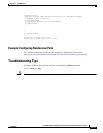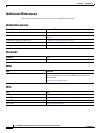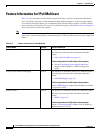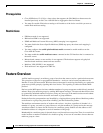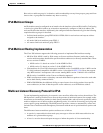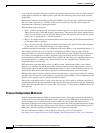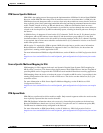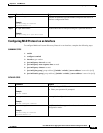
42-3
Cisco ASR 901 Series Aggregation Services Router Software Configuration Guide
OL-23826-09
Chapter 42 IPv6 Multicast
Feature Overview
How active a multicast group is, its duration, and its membership can vary from group to group and from
time to time. A group that has members may have no activity.
IPv6 Multicast Groups
An IPv6 address must be configured on an interface for the interface to forward IPv6 traffic. Configuring
a site-local or global IPv6 address on an interface automatically configures a link-local address and
activates IPv6 for that interface. Additionally, the configured interface automatically joins the following
required multicast groups for that link:
• Solicited-node multicast group FF02:0:0:0:0:1:FF00::/104 for each unicast and anycast address
assigned to the interface
• All-nodes link-local multicast group FF02::1
• All-routers link-local multicast group FF02::2
IPv6 Multicast Routing Implementation
The Cisco IOS software supports the following protocols to implement IPv6 multicast routing:
• MLD for IPv6: MLD is used by IPv6 routers to discover multicast listeners (nodes that want to
receive multicast packets destined for specific multicast addresses) on directly attached links. There
are two versions of MLD:
–
MLD version 1 is based on version 2 of the IGMP for IPv4
–
MLD version 2 is based on version 3 of the IGMP for IPv4.
• IPv6 multicast for Cisco IOS software uses both MLD version 2 and MLD version 1. MLD version
2 is fully backward-compatible with MLD version 1 (described in RFC 2710). Hosts that support
only MLD version 1 interoperates with a router running MLD version 2. Mixed LANs with both
MLD version 1 and MLD version 2 hosts are likewise supported.
• PIM is used between routers so that they can track which multicast packets to forward to each other
and to their directly connected LANs.
• PIM in PIM SSM has the additional ability to report interest in receiving packets from specific
source addresses (or from all but the specific source addresses) to an IP multicast address.
Multicast Listener Discovery Protocol for IPv6
To start implementing multicasting in a network, users must first define who receives the multicast. The
MLD protocol is used by IPv6 devices to discover the presence of multicast listeners (for example, nodes
that want to receive multicast packets) on their directly attached links, and to discover specifically which
multicast addresses are of interest to those neighboring nodes. It is used for discovering local group and
source-specific group membership. The MLD protocol provides a means to automatically control and
limit the flow of multicast traffic throughout your network with the use of special multicast queriers and
hosts.
The differences between multicast queriers and hosts are as follows:
• A querier is a network device that sends query messages to discover which network devices are
members of a given multicast group.
• A host is a receiver that send report messages to inform the querier of a host membership.



